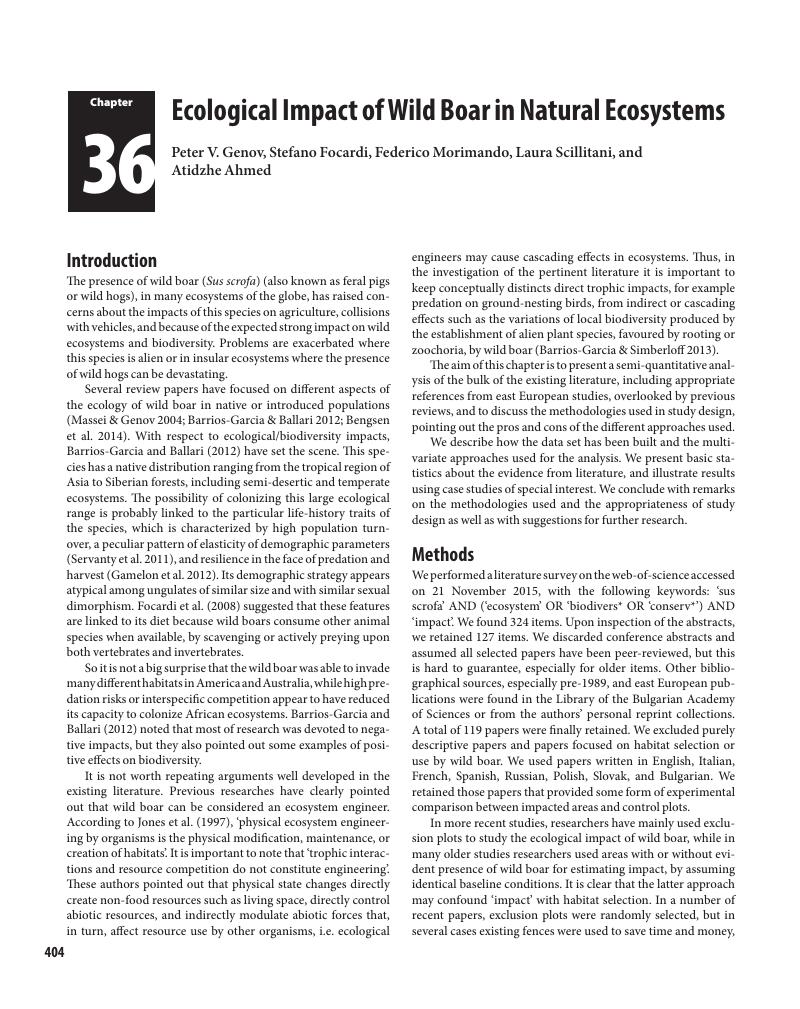Book contents
- Ecology, Conservation and Management of Wild Pigs and Peccaries
- Ecology, Conservation and Management of Wild Pigs and Peccaries
- Copyright page
- Dedication
- Contents
- Contributors
- Foreword
- Acknowledgements
- Introduction
- Part I Evolution, Taxonomy, and Domestication
- Part II Species Accounts
- Part III Conservation and Management
- 26 Conservation of Wild Pigs and Peccaries
- 27 Modelling Pygmy Hog Habitat to Inform Habitat Management
- 28 Introduced Wild Pigs in North America: History, Problems and Management
- 29 Biological Invasion of Wild Boar and Feral Pigs Sus scrofa (Suidae) in South America: Review and Mapping with Implications for Conservation of Peccaries (Tayassuidae)
- 30 Feral Pigs in Australia and New Zealand: Range, Trend, Management, and Impacts of an Invasive Species
- 31 Wild Boar Management in Europe: Knowledge and Practice
- 32 Resolving Conflict Between Farmers and Wild Boar in Europe and Northern Asia
- 33 Human Dimensions of Wild Boar: The Need to Include People in Decision-making Processes
- 34 A Genomic Perspective on Wild Boar Demography and Evolution
- 35 Disease Transmission at the Interface between Wild and Domestic Suiform Species in the Old and New Worlds
- 36 Ecological Impact of Wild Boar in Natural Ecosystems
- 37 Ex-situ Conservation of Wild Pigs and Peccaries: Roles, Status, Management Successes and Challenges
- 38 Antimicrobial Resistance in Wild Boar in Europe: Present Knowledge and Future Challenges
- Index
- References
36 - Ecological Impact of Wild Boar in Natural Ecosystems
from Part III - Conservation and Management
Published online by Cambridge University Press: 21 November 2017
- Ecology, Conservation and Management of Wild Pigs and Peccaries
- Ecology, Conservation and Management of Wild Pigs and Peccaries
- Copyright page
- Dedication
- Contents
- Contributors
- Foreword
- Acknowledgements
- Introduction
- Part I Evolution, Taxonomy, and Domestication
- Part II Species Accounts
- Part III Conservation and Management
- 26 Conservation of Wild Pigs and Peccaries
- 27 Modelling Pygmy Hog Habitat to Inform Habitat Management
- 28 Introduced Wild Pigs in North America: History, Problems and Management
- 29 Biological Invasion of Wild Boar and Feral Pigs Sus scrofa (Suidae) in South America: Review and Mapping with Implications for Conservation of Peccaries (Tayassuidae)
- 30 Feral Pigs in Australia and New Zealand: Range, Trend, Management, and Impacts of an Invasive Species
- 31 Wild Boar Management in Europe: Knowledge and Practice
- 32 Resolving Conflict Between Farmers and Wild Boar in Europe and Northern Asia
- 33 Human Dimensions of Wild Boar: The Need to Include People in Decision-making Processes
- 34 A Genomic Perspective on Wild Boar Demography and Evolution
- 35 Disease Transmission at the Interface between Wild and Domestic Suiform Species in the Old and New Worlds
- 36 Ecological Impact of Wild Boar in Natural Ecosystems
- 37 Ex-situ Conservation of Wild Pigs and Peccaries: Roles, Status, Management Successes and Challenges
- 38 Antimicrobial Resistance in Wild Boar in Europe: Present Knowledge and Future Challenges
- Index
- References
Summary

- Type
- Chapter
- Information
- Ecology, Conservation and Management of Wild Pigs and Peccaries , pp. 404 - 419Publisher: Cambridge University PressPrint publication year: 2017
References
- 10
- Cited by



